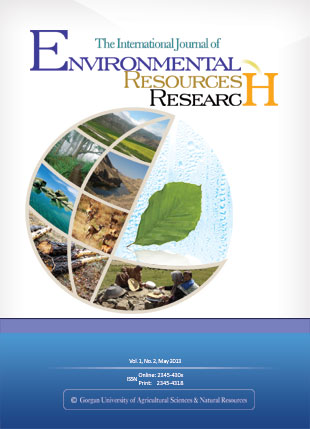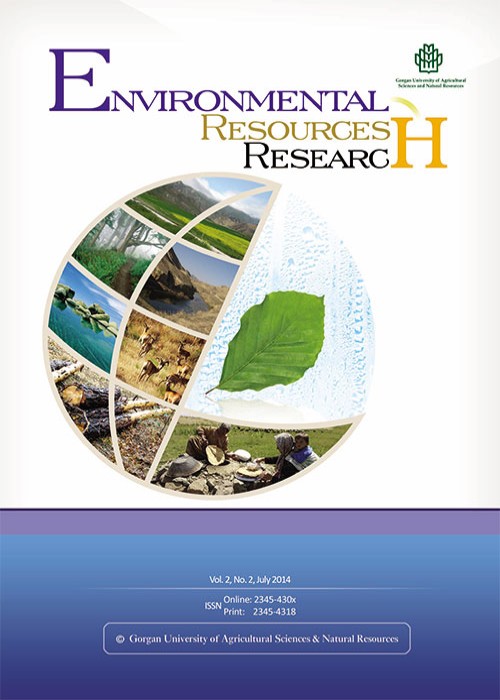فهرست مطالب

Journal of Environmental Resources Research
Volume:1 Issue: 2, Winter - Spring 2013
- تاریخ انتشار: 1392/09/29
- تعداد عناوین: 7
-
-
Page 107Investigation on structure and dynamics of natural forest ecosystems is an important issue for silvicultural decisions. The aim of this study was to analyse the dynamics and structure of a beech stand during a 5-year period in the Shast Kalateh forest in eastern Caspian region, North of Iran. Data were collected from a 16.9ha permanent research plot established in a natural unlogged stand from the year 2006 to 2011. All living trees with a diameter at breast height ≥7.5 cm were measured. The permanent research plot was dominated by six species (beech, hornbeam, ironwood, velvet maple, Caucasian alder and date plum). The analysis of results showed that the total living stand density and volume fluctuated between 302 and 287 trees per ha and 504 to 472 m3ha-1 over the 5-year period, respectively. Results also showed that the total density of deadwood increased from 21 to 27.7 Nha-1 over the 5 years. During the study, the volume of dead trees was 15.3 m3ha-1, equal to 3% mortality in the volume of living trees in the year 2006. Live trees of beech, hornbeam and ironwood illustrated reverse J distribution, both for 2006 and 2011. The maximum proportion of stem number was found in the small diameter class (≤30 cm), whereas the maximum volume of trees was found in the largest diameter class (>75 cm). Another remarkable change was related to the amount of total volume in the diameter class (35-50 cm), which was 37.4 and 40.3 m3ha-1 in 2006 and 2011, respectively. The proportion of stem number in diameter classes of 35-50 and >75 cm increased from 2006 to 2011, while the stem number of ≤ 30 cm and 55-70 cm diameter classes decreased with values of -8.18 and -2.72 regarding the year 2006. Also, the highest volume was calculated in the diameter class >75 cm in the years 2006 and 2011 (248.3 and 254.3 m3ha-1), respectively. The results showed that the highest mortality happened among young trees with diameter ≤ 30 cm. It can be concluded that Shast Kalateh forest as a part of beech forests is passing through a degradation phase, due to the significant number and volume of dead trees.Keywords: Forest Dynamics, Structural characteristics, Oriental beech, Caspian region, Shast Kalateh
-
Page 131Reclamation of sandy land in arid and semi-arid areas has a high potential in increasing carbon sequestration and improving soil quality. The objective of this study was to assess the amount of soil carbon sequestration and enhancement of soil properties under plantation of two well-adapted species to desert environment, i.e Atriplex and Haloxylon. This study was conducted in Shahid Zenderuh Research Station in Jupar city of Kerman Province. In this region Atriplex canescens and Haloxylon ammodendron species have been planted for wind erosion control. According to the research objectives, 24 soil samples were taken from each depth (under canopy cover and control sites) through systematic-random method. Soil carbon sequestration was determined using Walkley-Black method. The results showed that the reclamation of severe sandy desertified land with these plants significantly increased soil organic carbon (SOC). SOC concentration in areas planted with Haloxylon and Atriplex species increased by 16.2 and 18.1 ton/ha respectively as compared to control. However, this amount in Atriplex plantation site was more than that observed in Haloxylon plantation area. Therefore, it is concluded that A.canescens has better performance in soil carbon sequestration in the sandy study area compared to that of H.ammodendron.Keywords: Atriplex, Haloxylon, Soil carbon sequestration, Land degradation
-
Page 141The relationship between topography, land use, and topsoil moisture storage was investigated for a small catchment with undulating deep loess hill slopes in the south of the Netherlands. For a period of 10 months, soil moisture profiles were measured weekly at 15 locations throughout the catchment. A Generalized Additive Model was employed to find relationships between various factors influencing soil moisture. The model defines a water balance as a sum of non-linear components. The water balance was applied to our data at various spatial (catchment, response unit, hillslope and plot), and temporal (monthly, weekly and daily) scales. Each of the water balance components was parameterized as a function of topographic, land use, weather and antecedent soil moisture variables. The model framework is hierarchical: it starts at the coarsest spatio-temporal resolution, the water balance components found here act as constraints when identifying models at finer resolutions. It turned out that the importance of land-use variables varied considerably with temporal resolution. At coarse resolutions land-use was unimportant, whereas at finer resolutions it became more relevant. Land use was equally important over all spatial resolutions (response unit and finer). Topography was mostly relevant at the plot scale. The water balance terms became increasingly non-linear at finer scales. Evapotranspiration depended mainly on reference evapotranspiration and crop cover. Drainage to deeper layers depended mainly on soil moisture and to a lesser extent on topography. Lateral transport was weakly dependent on topography. It appeared that autoregressive components became increasingly important at finer temporal resolutions.Keywords: GAM, SWAP, Topography, Landuse, Soil moisture
-
Page 167The present study considered the situation of kilka stocks using overfished biomass threshold, fishing effort ratio and fishing mortality proxy during 1991-2010. The CPUE index of anchovy kilka and mixed-species (three species of Kilka) indicated no overfishing from 1991 to 2000. In 2000, the CPUE ratio neared the “in danger” region, and subsequently fell into the “overfished” region from 2001 to 2007 for both anchovy and mixed-species of kilka. The CPUE ratios of common kilka have been in an overfished state during 1991-2003. During 2008-2010 the biomass increased and the CPUE ratio of common kilka and mixed-species upgraded to non-overfished region. The control rule of anchovy kilka showed that overfishing was occurred from 1998 to 2010, and overfishing-effort was exceeded the overfishing threshold (MFMT) by 12-66%. The trajectory of the phase-plot of biomass proxy (CPUE ratio) and fishing mortality proxy (effort ratio) of anchovy kilka showed that the status of the fishery of anchovy kilka has generally reduced since 1998 and collapsed to the lowest level in 2010. The trajectory for common kilka has generally increased since 1991 getting close to the fisheries management target in 2007. In conclusion, in the new condition, common kilka is the main species in the Caspian Sea. For stock recovery of anchovy kilka, the catch of three species of kilka must be restricted during reproduction periods, and also, a coordinated international effort should be put into effect.Keywords: Overfished biomass threshold, Fishing effort ratio, Fishing mortality proxy, Kilka, Caspian Sea
-
Page 181The expanding phenomenon of dieback is caused by the reaction of trees against the harmful biotic and abiotic factors that lead to dying of shoots and branches of trees from upper crown to lower crown. This phenomenon spreads throughout the leaves and branches and all parts of the plant and may finally lead to the death of the plant. This study aimed to identify species dieback with especial attention to Carpinus betulus and the spread of dieback in this species using topography factors in series one of Shast Kalate Forest, north east of Iran in Golestan Province. In the study area, a statistical network with dimensions of 600×800 m was randomly and systematically designed (network of plots) and cluster sampling with six trees was applied in every plot. Topographical factors (altitude, slope direction and percentage) in each plot were taken. Analysing the data indicated that 28% of the total stands suffered from different degrees of dieback among which 22% belonged to the Carpinus betulus species. The percentage of dieback stands of this species in different classes of height had no meaningful difference, but it was located more in western aspect and gradients of less than 20%.Keywords: Dieback, Topography, Carpinus betulus, Morphologic characteristics
-
Page 191Fish culture sites produce considerable volume of effluents which could have effects on water quality and downstream aquatic systems. The aim of this study was to assess the potential impacts of Trout farm effluents on water quality of Zaringol stream (Golestan, Iran) based on NSFWQI and WQI indexes. For this, physicochemical water quality parameters were measured each season from 14 stations during December 2009 to September 2010. The average value of NSFWQI was 53.21 and it showed spatial and temporal variation. The maximum value or best water quality condition (74.5) and minimum value of NSFWQI or the worst condition (50.93) belonged to stations 1 and 2 respectively. Results of seasonal variations of NSFWQI showed that the maximum and minimum values were 59.62 and 53.82 in autumn and spring respectively. Similar to the NSFWQI, the WQI index changed between different stations. Stations 2 and 8 had the lowest value (0.76), station 7 had the highest (1.01) and the mean value was 0.88. Although the temporal variations of WQI were low, the highest value was calculated for summer (0.94) and the lowest one (0.81) for autumn. According to the results of NSFWQI, WQI and physicochemical parameters, water quality condition of Zaringol stream is average and need a change in strategies of water quality management in the area. It seems that effluents entering from Trout farms in spring and summer are reasons of the decline in water quality and it is necessary to use treatment methods based on environmental standards to avoid the future risks.Keywords: Trout farm effluent, Water quality, NSFWQI, WQI, Zaringol stream
-
Page 203The fact that the world is losing its biodiversity due to human activities, particularly around the tropical forest region, has been widely known. One of the biggest threats to biodiversity is the edge effects, especially in isolated and fragmented habitats. The change in understorey bird community composition and habitat variables were studied along an edge-to-interior gradient in a 1248 ha lowland rainforest patch in peninsular Malaysia. Birds and environmental variables such as vegetation structure and litter depth were detected within a 25 m radius of each of 93 sampling points distributed throughout the forest. Species composition differed along the edge-interior gradient at the guild and species level, although only a few species were entirely confined to either edge or interior habitat. Based on bird-habitat associations along the edge-interior gradient, two groups were distinguished. Abundance of the edge-specialist group, mainly foliage-gleaning insectivores and insectivore/ frugivores, was positively correlated with ground cover, light intensity, shrub cover, temperature, and percent of shrub cover between 0.5 and 2 m height. Some of these edge-preferring species also occurred in the matrix surrounding the patch and were extremely abundant, which may create problems for forest species. In contrast, the interior-specialist group, mainly terrestrial insectivores, avoided the forest edge and was positively associated with humidity, canopy cover, number of dead trees, percentage of litter cover, and depth of the litter layer. From a conservation perspective, forest remnants in the lowlands of Peninsular Malaysia that have a deep leaf litter layer, a dense canopy cover, high number of dead trees, and high relative humidity are able to support regionally significant understorey bird species that are sensitive to edge effects. As such these forests have important conservation value.Keywords: Birds, Community analysis, Density, Diversity, Isolated forest, Population analysis


